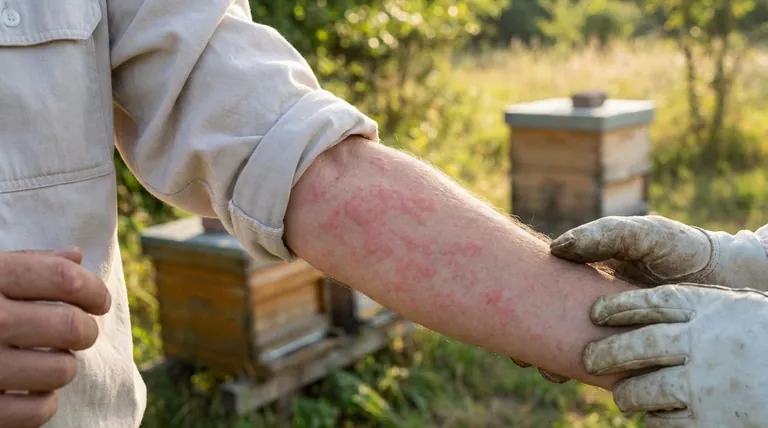The duration of urticaria (hives) is key to understanding the condition. An individual hive, or welt, is typically very short-lived, often fading within a few hours and almost always disappearing within 24 hours. However, the overall condition of having hives can last much longer, as new welts may appear as old ones fade, giving the impression of a continuous rash.
The critical distinction is not how long a single welt lasts, but how long the overall condition persists. Hives are classified as acute if the episode lasts less than six weeks and chronic if it continues for more than six weeks.

The Two Timelines of Hives: Acute vs. Chronic
The most important factor in understanding your hives is the total duration of the outbreak, which separates the condition into two distinct categories.
Acute Urticaria (The Common Case)
Acute urticaria is defined as an outbreak of hives that resolves completely within six weeks.
This is the most common form of hives. The welts may come and go during this period, but the entire episode from start to finish is less than six weeks.
Often, acute hives are caused by a specific, identifiable trigger, such as a viral infection, a food allergy, a medication, or an insect sting.
Chronic Urticaria (The Persistent Case)
Chronic urticaria is diagnosed when hives appear on most days of the week for a period of six weeks or longer.
This form can be more complex, and in many cases, a specific external trigger cannot be identified. This is often referred to as chronic spontaneous urticaria.
While the overall condition is long-lasting, it's crucial to remember that individual welts still behave the same way—they appear and fade within 24 hours.
What's Happening Under Your Skin?
Understanding the underlying mechanism helps clarify why hives behave the way they do.
The Role of Histamine
Hives are the result of specialized cells in your skin, called mast cells, releasing histamine and other chemicals.
This release causes tiny blood vessels in the skin to leak fluid. This fluid pools just under the skin's surface, creating the swollen, red welts characteristic of hives.
Histamine is also responsible for the intense itching that accompanies the condition.
The Lifespan of an Individual Welt
A single hive, or "wheal," is a transient event. The leaked fluid is gradually reabsorbed by the body.
This is why an individual spot will almost always fade without a trace in less than 24 hours. If a specific spot lasts longer than that, it may indicate a different type of skin condition.
New welts can form in different locations as long as the mast cells continue to be activated and release histamine.
Common Pitfalls in Understanding Hives
Misinterpreting the duration and behavior of hives can lead to unnecessary anxiety.
Mistaking New Welts for Old Ones
It's easy to assume a single hive has lasted for days. In reality, you are likely seeing old welts fade as new ones appear in different or adjacent locations. This cycle of fading and appearing is the classic sign of urticaria.
Focusing Only on External Triggers
While acute hives often have a clear trigger, chronic hives frequently do not. Searching endlessly for an external allergic cause for a chronic condition can be frustrating and is often fruitless. Many chronic cases are driven by internal autoimmune processes rather than something you ate or touched.
Making the Right Choice for Your Goal
Understanding the timeline of your hives is the first step toward effectively managing them and seeking the right help.
- If your hives have lasted less than a few weeks: Your focus should be on symptom relief with antihistamines and identifying any obvious recent triggers (like a new medication or recent illness).
- If your hives have persisted for more than 6 weeks: It is highly recommended to see a doctor or specialist (allergist/immunologist or dermatologist) for a proper diagnosis of chronic urticaria and a more advanced treatment plan.
- If you ever experience hives with swelling of the tongue or lips, or have difficulty breathing: Seek emergency medical care immediately, as this can be a sign of a life-threatening reaction.
Knowing whether your condition is acute or chronic is the most important step toward finding lasting relief.
Summary Table:
| Hives Type | Duration | Key Characteristics |
|---|---|---|
| Acute Urticaria | Less than 6 weeks | Often triggered by allergies, infections, or medications. Individual welts fade within 24 hours. |
| Chronic Urticaria | 6 weeks or longer | Often no clear external trigger; may be autoimmune. Individual welts still fade within 24 hours. |
Struggling with persistent hives? You're not alone.
Understanding the timeline of your hives is the first step toward effective management. If you're a beekeeping professional or distributor, you know that managing health is as crucial as managing your hives. At HONESTBEE, we supply the highest-quality beekeeping supplies and equipment to commercial apiaries and distributors, helping you focus on what you do best.
Let us help you secure your operation's success. Contact our expert team today to discuss your wholesale needs and discover how our reliable equipment can support your business.
Visual Guide
